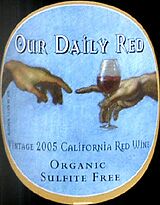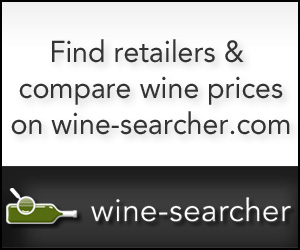|
No sulfites added
Every summer during vacation season, when North American wine enthusiasts head to Europe to see the sights and enjoy good food and wine, I get a flurry of E-mail questions like this:
We just returned from a trip to France and the wine was markedly different than the wine in the U.S. No hangovers, headaches, stuffiness - we could drink considerably more wine than we can in the U.S. with absolutely no side effects! We were told by some friends that there are no sulfites added to French wine (though the U.S. makes them add them to any French wine imported into the U.S.) Is that true? Well, no, actually it's not. Sulfites are a natural, organic preservative that humans have been using in wine and other foods for several thousand years. The only difference between France and the U.S. is that the U.S. requires a warning label, and warning labels create the unfortunate impression that where there's a warning, there must be something dangerous afoot. And in fact there is, but that danger threatens only a relative handful of individuals - sulfite-sensitive asthmatics - for whom any exposure to sulfites could trigger potentially fatal respiratory problems. But sulfite-sensitive adults already know what they must avoid - a list that includes wine, fruit juice, sausages, salad bars and many other foodstuffs that routinely use sulfiting in production. As I wrote when we last featured this topic on Sept. 1, 2003, the U.S. Food and Drug Administration (FDA) includes sulfites on its "generally recognized as safe" (GRAS) list of food additives. But U.S. regulators have also required since 1987 that all foodstuffs containing more than 10 parts per million (ppm) of sulfites must bear a warning label. Curiously, moreover, regulators set a maximum limit of 350 ppm for sulfites in alcoholic beverages, while allowing some processed foods up to 6,000 ppm. If you get a headache or a stuffy nose after drinking wine, you may be allergic to something - very likely the histamines in some red wines, or in the case of hangovers, simple over-indulgence. But it's not the sulfites. So why do so many travelers (me, too!) report being able to enjoy a little harmless over-indulgence on vacation without the recriminations that would surely ensue at home? My guess, frankly, is that it's mostly psychological. We're traveling, we're relaxed, we're having a great time, and we shrug off minor irritations that would seem more bothersome on a working day. Whatever the explanation of this happy consequence, I can say one thing with certainty: It doesn't have anything to do with sulfites in the wine. To repeat: The only difference between the wines we drink in France (or Italy, or anywhere else in Europe) and the wines we enjoy at home is the warning label. By coincidence, over the weekend I also picked up a modestly priced California wine that's labeled "organic sulfite free," terminology that requires a little explanation. Under relatively recent federal regulations governing organic labeling, a wine made with organic vineyard practices but using sulfites as a natural preservative must be labeled "Made with organically grown grapes." To qualify for the label "organic sulfite free," it must have no sulfites added during production; however, it may contain up to 10 parts per million naturally occurring sulfites, a small dose that occurs as a byproduct of fermentation. In short, "sulfite-free" isn't, really, although the sulfites are at such a low level that even sensitive individuals shouldn't be able to detect them.
A blend of Fresno Syrah and Carignan and Mendocino Cabernet Sauvignon labeled as "Certified organic by guaranteed organic certification agency," "USDA Organic" and "Organic Sulfite Free," this is a very dark ruby wine, showing a distinct haze when it's held up to the light. Simple red-fruit aromas focuse on plums and berries. Tart and "grapey," red plums and wine grapes and a tart, zippy snap of citrus that borders on sour. A distinctly prickly tickle of just-perceptible carbonation suggests that it may be prone to a secondary fermentation in the bottle, which would not be a good thing. I'd rate it as drinkable but not well-balanced, with some indication that it may be less than fully stable on the shelf. (June 24, 2006) FOOD MATCH: Simple, fruity and acidic, it serves well with red meats from burgers to my choice, pan-seared rib eye steak; it should also make a decent vegetarian match with Cheddar or other relatively mild cheese. VALUE: It's idiosyncratic, but not a bad value under $10, provided you're willing to take the risk that it has held up in the bottle. WHEN TO DRINK: I suggest treating a wine made without preservatives as you would fresh fruit: Enjoy it while it's fresh, but don't expect it to last.
WEB LINK:
FIND THIS WINE ONLINE:
TALK ABOUT WINE ONLINE:
Today's article is also posted in our Netscape WineLovers Community. To contact me by E-mail, write wine@wineloverspage.com. I'll respond personally to the extent that time and volume permit.
PRINT OUT TODAY'S ARTICLE  California Wine Club: Santa's Summer Sale Going On Now!
California Wine Club: Santa's Summer Sale Going On Now!Reserve now and save! Take advantage of the BIGGEST SAVINGS ever offered by The California Wine Club. Reserve your holiday gift orders now and save up to $89 per gift, plus receive no billing and no shipping until December 2006! For details or to place an order, please visit www.cawineclub.com or call 1-800-777-4443. Santa's Summer Sale has become one of The California Wine Club's most popular benefits. Save money, save time and save yourself some frantic holiday-shopping days. Changes can be made to your gift reservations any time before Nov. 22, 2006.
Santa's Summer Sale ends August 31, 2006. Visit MoCool 2006: Sweet Sixteen & Bubbly With the selection of Saturday, Aug. 26 as a definite date, plans are now firm for MoCool 2006, which will offer a double-barrelled theme this year to accommodate both wine collectors and those without older wines in their cellars. Titled "Sweet Sixteen & Bubbly," MoCool's primary theme - "Sweet Sixteen" - will hail the excellent world-wide vintage of 1990. There's plenty of opportunity to participate even if you're unable to bring a 16-year-old wine, however, as the "Bubbly" portion of the theme is interpreted to include both Champagne and imposters and a worldwide choice of dessert wines. MoCool is a non-profit, non-commercial venture, organized since 1992 by a volunteer group of 'net-wired wine lovers in the Ann Arbor and Detroit area of southern Michigan. The goal is a non-snobby, cooperative, affordable weekend for cyberwine fans to get together and enjoy wine, food, and each other's company. Participants bring wine and are assessed charges calculated to offset the actual costs of venue and food.
The primary event is a Saturday afternoon and evening picnic at a rural location near Ann Arbor. For more information, and to get on the MoCool E-mail list, visit the MoCool Home Page This week on WineLoversPage.com Some highlights of recent articles on WineLoversPage.com that I hope you'll enjoy:
• Bucko's Wine Reports: Late Spring 2006 Releases
• Hot topics in our WineLovers' Community
Marsanne ... like it or don't Last Week's Wine Advisor Index The Wine Advisor's daily edition is usually distributed on Mondays, Wednesdays and Fridays (and, for those who subscribe, the FoodLetter on Thursdays). Here's the index to last week's columns:
• Doon to earth - Uva di Troia (June 23, 2006)
• Pinot from where? (June 21, 2006)
• Whassamadda wit' Pinot Grigio? (June 19, 2006)
• Complete 30 Second Wine Advisor archive:
• Wine Advisor FoodLetter: Lemongrass (June 22, 2006)
• Wine Advisor Foodletter archive:
SUBSCRIBE: Administrivia To subscribe or unsubscribe from The 30 Second Wine Advisor, change your E-mail address, or for any other administrative matters, please use the individualized hotlink found at the end of your E-mail edition. If this is not practical, contact me by E-mail at wine@wineloverspage.com, including the exact E-mail address that you used when you subscribed, so I can find your record. We do not use our E-mail list for any other purpose and will never give or sell your name or E-mail address to anyone. I welcome feedback, suggestions, and ideas for future columns. To contact me, please send E-mail to wine@wineloverspage.com All the wine-tasting reports posted here are consumer-oriented. In order to maintain objectivity and avoid conflicts of interest, I purchase all the wines I rate at my own expense in retail stores and accept no samples, gifts or other gratuities from the wine industry.
Monday, June 26, 2006
|

 Nevada County Wine Guild 2005 "Our Daily Red" California Red Wine ($9)
Nevada County Wine Guild 2005 "Our Daily Red" California Red Wine ($9)



